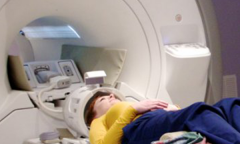EEG (Electroencephalogram)
An Electroencephalogram (EEG) records the electrical activity of the brain by picking up the electrical signals from the brain cells. These signals are picked up by electrodes attached to the head and are recorded on a computer. The recording shows how the brain is working.
What does an EEG show?
An EEG gives information about the electrical activity of the brain during the time the test is happening.
When someone has an epileptic seizure their brain activity changes. This change, known as epileptiform brain activity, can sometimes be seen on an EEG recording. Some people can have epileptiform brain activity even when they do not appear to be having a seizure, so an EEG can be particularly useful for them.
Epileptiform activity can sometimes be provoked (brought on) by deep breathing. The test may include deep breathing to see if epileptiform activity can be provoked and recorded.
Flashing lights during the EEG
Some people with epilepsy have seizures that are started, or ‘triggered’, by flashing lights. This is called photosensitive epilepsy and it affects up to 5% of people with epilepsy.
An EEG will usually include testing for photosensitive epilepsy. This involves looking at a light which will flash at different speeds. If you are worried about this you can talk to the technician.
Sleep-deprived EEG
For most people there is more chance of showing irregular brain activity when they are tired or when they are going to sleep.
Having a sleep-deprived EEG might help to get a more useful reading. This test is done in the same way as a normal EEG but you sleep during the test. To help you sleep, you may be asked to stay awake some, or all, of the night before. In some cases you may be given a mild sedative to help you to sleep.
Ambulatory EEG
An ambulatory EEG works in the same way as a normal EEG but is portable. During the test, you wear a small machine on a belt around your waist. Because it is portable you can move around and carry on with your normal day-to-day routine while the recording happens.
This type of EEG allows brain activity to be recorded for several hours. Because the brain activity is recorded for longer, there is more chance of a seizure being recorded than during the normal 30 minute test.
Video telemetry
Video telemetry happens in hospital, usually over a few days. During your stay you will have your own room. A video camera, often mounted on the wall, will record what you are doing. At the same time you will wear a portable EEG so that you are able to move around your room.
Sometimes you may be able to have video telemetry at home with portable monitoring and video equipment but this is not available in all EEG departments.
Being videoed while wearing an EEG means that if you have a seizure your doctors can compare the electrical activity of your brain with what is happening to your body.
What do my results mean?
An EEG can usually show if you are having a seizure at the time of the test, but it can’t show what happens to your brain at any other time. So even though your test results might not show any unusual activity it does not rule out having epilepsy. Some types of epilepsy are very difficult to identify with an EEG.
People who do not have epilepsy can sometimes have irregular activity on their EEG. So a result where there is irregular activity does not necessarily mean that the person has epilepsy. See more about how epilepsy is diagnosed.
What happens during an EEG test?
Like an ECG, the electrodes only record electrical activity - they do not give out electrical signals and they do not hurt.
Before the test, the technician measures your head to work out where to place the electrodes. Each electrode is held in place using a sticky paste. Once the electrodes are attached they are connected to the recording machine.
The test lasts about 30 minutes and you will probably be sitting or lying down.
Epilepsy Society is grateful to Dr F J Rugg-Gunn, Consultant Neurologist & Honorary Associate Professor, Clinical Lead, Chalfont Centre for Epilepsy, who reviewed this information.
Information updated: February 2024
MRI (Magnetic Resonance Imaging)
An MRI scan will not say for certain whether the person has epilepsy or not. But alongside other information, it might help the specialist to decide what the likely cause of the seizures is.
How epilepsy is diagnosed
Diagnosing epilepsy is not simple. Doctors gather lots of different information to assess the causes of seizures. If you have had two or more seizures that started in the brain you may be diagnosed with epilepsy.
Tests for epilepsy
Blood tests, an Electroencephalogram (EEG) and scans are used to gather information for a diagnosis. Tests on their own cannot confirm or rule out epilepsy.
Want to know more?
For a printed copy contact our Helpline



